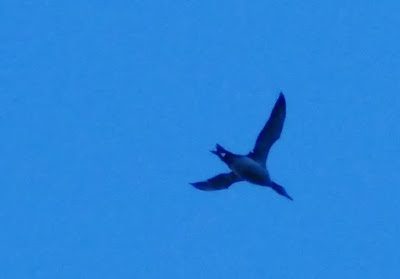I blogged about August on the patch but what of the rest of the autumn? It turned out to be a memorable one: rare and scarce species, variety and pure migration spectacle.
Divers
A good autumn passage of divers was topped by a site first White-billed Diver flying inland to the W over the bridges with 3 Great Northern Divers on 23rd October. An amazing sight and had to be the bird of the autumn on the patch. This record came during a strong showing of White-billed Divers in October/November 2021 in Fife (several records from Fife Ness) and more widely in E Scotland/NE England.
Eight Great Northern Divers flew W inland during the autumn as did four Black-throated (always the scarcest diver here). A total of 1,115 Red-throated Diver flew W inland with a peak day count of 114 on 1st October.
 |
| A Great Northern Diver flying inland overhead |
 |
| A very close Black-throated Diver flying inland on 19th November was another magic moment, it was so close I could hear its wing beats. |
 |
| A flock of red-throated divers flying inland on the peak day for passage (114 on 1st October) |
Geese
Pink-footed Geese are a regular feature of the autumn and a total of 19019 was recorded with a peak of 3906 on 25th September. Taiga Bean Geese are a regular feature of the autumn passage in small numbers as they head up the Forth to wintering grounds on the Slamannan plateau, in recent years over 50% of the total UK population have wintered on the Slamannan plateau with an average wintering flock size of 240. On the patch a total of 14 were recorded this year with a peak of 7 on 6th October.
Barnacle Geese typically have a narrow window for autumn passage (birds heading from Svalbard to the Solway Firth) and a total of 136 were all in October with a peak of 98 on 13th October. Pale-bellied Brent are scarce at the W end of the Forth and this year the only record was four on 26th September.
Skuas
A total of 108 Arctic Skua was my best ever total with a peak of 16 on 5th September. My best ever showing of Long-tailed Skua saw a total of 5 Juveniles (including the August bird mentioned in a previous post). Six Pomarine Skuas comprised three adults (an early one on 17th July and two on October 22nd) and three Juveniles (single birds flying inland on three separate dates in September). Great skuas had a relatively poor year: a total of 36 from a total of 270 observation hours compared with a peak annual total of 82 from 250 observation hours in 2018.
 |
| Some of the views of skuas heading inland, like this dark Juv Arctic, can be very close. |
 |
| Overland passage of Bonxie is a regular autumn feature but numbers were low this year |
 |
| The photos aren't great but I actually had great views of this intermediate Juv Long-tailed Skua as it flew towards me from the north. By the time I got the camera up it was heading away inland. |
 |
| I could only manage very distant record shots, but this was my favourite encounter with a Juv Long-tailed this autumn, a striking pale morph that flew inland with an Arctic Skua on 3rd October |
 |
| A dark Juv Pomarine Skua heading inland. |



No comments:
Post a Comment